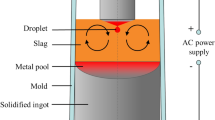Abstract
In situ distortion of fibrous-cement slates is brought about by exposure to different temperature and hygrometric gradients across the material. The aim of this research was to understand in detail the effect of each compositional change on the physical properties, and to use this knowledge for the manufacture of slates which would exhibit improved mechanical properties. A previous paper described the experimental measurements conducted to evaluate the impact of changing the composition of the slates on the physical properties controlling hydrous transfer. In the present paper, the physical parameters obtained from the experimental work are used in a numerical model. The numerical model, NSAT, employs a finite-element method to solve the non-linear diffusion equation. The numerical model was validated and subsequent simulations are described. A theoretical model has been obtained which shows good agreement between the results from practical tests at the experimental station and the predictions of the numerical model. The results also confirm the previous hypotheses of the industrial partner. The theoretical model obtained may be used for the prediction and specification of industrial materials having improved mechanical properties, and in particular, exhibiting less distortion.
Résumé
Les déformations locales dans les ardoises de fibrociment peuvent être engendrées par l'existence de gradients de température et d'hygrométrie au sein du matériau. Le but de ce travail est de comprendre en détail l'effet des modifications de composition des ardoises sur leurs propriétés physiques et d'utiliser ces connaissances dans la fabrication d'ardoises présentant de meilleures propriétés mécaniques. Un article précédent a décrit l'effet des traitements subis par les ardoises sur les paramètres physiques influant sur les transferts d'humidité. Dans cet article, les paramètres physiques sont utilisés dans un modèle numérique, NSAT. Le modèle numérique emploie la méthode des éléments finis pour résoudre l'équation non-linéaire de diffusion. D'abord le modèle numérique a été validé. Ensuite d'autres simulations plus complexes sont présentées. Les calculs numériques ont clairement mis en évidence les différents types de comportement de séchage qui correspondent aux diverses observations expérimentales du partenaire industriel. Le modèle numérique peut être utilisé pour la prévision et l'élaboration des matériaux industriels avec un meilleur comportement mécanique. En particulier, une dimunition de la déformation est attendue.
Similar content being viewed by others
References
Raoof, A. and Sabouraud, A., ‘Hydrous transfer within fibrouscement slates’,Mater. Struct. 30 (195) (1997) 22–28.
Humbert, P., ‘Application de la méthode des éléments finis aux écoulements en milieux poreux’,Bull. Lias. des P. et Ch.,132, July–Aug. 1984.
Humbert, P., ‘CESAR-LCPC: Progiciel de calcul par éléments finis adapté aux problèmes de génie civil’,Bull. Lias. des P. et Ch.,160 (1989) 112–115.
Humbert, P., Piau, J. M. and Santarelli, F. J., ‘The adaptation of a 3-D FEM code to the oil environment—Pore pressure diffusion’, Proc. 7th Int. Conf. on Computer Methods and Advances in Geomechanics, Ed. G. Beer (A. A. Balkema, Rotterdam, 1991).
Vachaud, G., ‘Contribution à l'étude des problèmes d'écoulement en milieux poreux non-saturés’, Ph.D. Thesis, Univ. of Grenoble, 1968.
Raoof, A., ‘An experimental and numerical study of hydrous transfer within fibrous-cement slates’, MPhil. Thesis, Nottingham Trent University, England, 1994.
Author information
Authors and Affiliations
Additional information
Editorial note A. Raoof and T. H. Doan are working at the Laboratoire des Matériaux et des Structures du Génie Civil of LCPC, France, which is a RILEM Titular Member. A. Sabouraud is working at Pont-à-Mousson SA, France, which is a RILEM Titular Member.
Rights and permissions
About this article
Cite this article
Raoof, A., Doan, T.H. & Sabouraud, A. Numerical simulation of hydrous transfer within fibrouscement slates. Mat. Struct. 30, 366–374 (1997). https://doi.org/10.1007/BF02480688
Issue Date:
DOI: https://doi.org/10.1007/BF02480688



